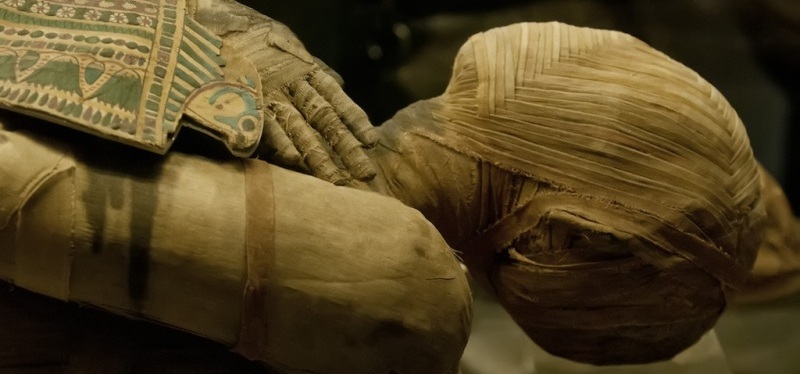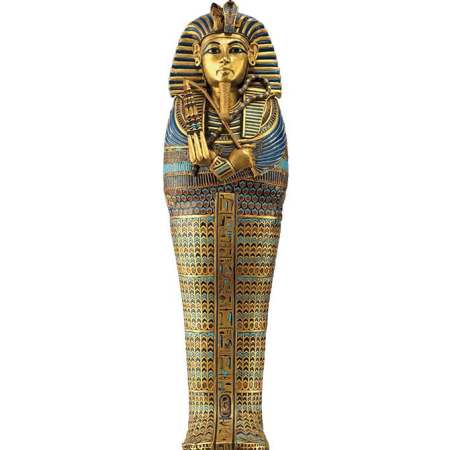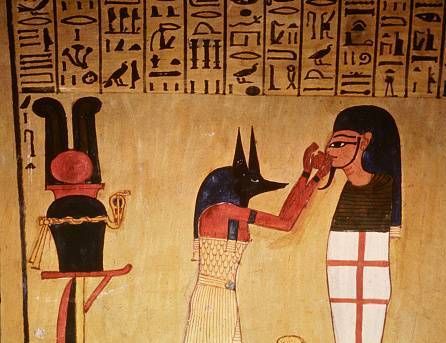
Think about the following questions.
1. What do you know about mummies and mummification?
2. Who do you think should be allowed to explore ancient sites?
3. What dangers might archaeologists encounter when searching ancient sites?
VOCABULARY PREVIEW
Match each New Academic Word List(NAWL) word with the correct definition.
- infect _____
- dampen _____
- symbolic _____
- suicide _____
- absorb _____
- organ _____
- a. to make less strong or intense
- b. the act of killing oneself
- c. to contaminate with germs
- d. to draw in (moisture)
- e. representative of something else
- f. an essential internal body part
THE CURSE OF THE MUMMY

"Death shall come on swift wings to him who disturbs the peace of the King." These are the words Howard Carter was reported to have seen carved in stone as he entered the tomb of King Tutankhamun, the famous pharaoh who ruled Egypt from 1333 to 1325 BCE. Egyptian sepulchers1 like that of King Tutankhamun contain curses to frighten those who would violate the tombs, and in what has come to be known as "the curse of the mummy," it is believed that tragedy and death befall those who disturb the graves of Egyptian kings.
In the 1930s, the belief in a mummy's curse was rekindled2 after the deaths of Carter's colleagues. Years earlier, in 1891, Howard Carter, then a young archaeologist from England, went to Egypt to study ancient Egyptian culture and to try to locate the unopened tomb of an ancient king. Because Egyptian kings were buried with gold and other valuable items, by the end of the 19th century, most tombs in the Valley of the Kings had been plundered3. Therefore, many archaeologists believed that there was nothing left to excavate4. Carter, however, believed there was at least one more undiscovered tomb, and he wanted to find it.
The great burial chambers in the Valley of the Kings contained the wrapped bodies of pharaohs, as well as items Egyptians believed would aid the kings in the afterlife. Before being buried for the afterlife, the bodies of the kings were carefully preserved by a process of embalming called mummification. When a body was mummified, the brain and other organs were removed and stored in large jars; then the skin, muscles, and bones were covered in a special salt for three months. At the end of the three months, after the salt had absorbed the water from the body, the body was wrapped in pieces of cotton soaked in pine resin (the liquid from pine trees). Through this process, the bodies of Egyptian kings have been preserved for thousands of years, and bodies that have undergone this embalming5 process are called mummies.
After years of working in Egypt studying various sites, and still convinced he would find an unopened tomb, Howard Carter approached wealthy British businessman Lord Carnarvon, who agreed to finance the search. After five unsuccessful years, however, Lord Carnarvon threatened to withdraw his patronage6. Carnarvon gave Carter just one more year within which to make a discovery. Returning to Egypt, Carter brought with him a canary, which was later believed to have been the harbinger7 of both success and disaster. It was in that year, 1922, that Carter discovered the tomb of King Tutankhamun, but days before the discovery, Carter's canary was killed by a cobra—once symbolic of the pharaohs.
In November of 1922, Howard Carter cut a hole in the stone door that stood in front of Tutankhamun's tomb. With him were Lord Carnarvon and twenty others, including archaeologists, workers, and servants. Upon opening the tomb, they found wonderful treasures, including a solid gold mask that covered the face and upper torso8 of King Tutankhamun's body. Soon, however, their celebrations were dampened by a number of tragedies.
Lord Carnarvon died in Egypt a few months after the opening of the tomb. At first, doctors could not identify the cause of his death, but they finally determined it to be pneumonia and blood poisoning caused by an infected mosquito bite. The British press reported that at the exact moment of his death, back in England, Lord Carnarvon's dog howled9 at the moon and then died. Rumors of a mummy's curse shook the British public when the mummy of Tutankhamun was unwrapped, and a wound was discovered on the pharaoh's left cheek in the same spot as the insect bite that had caused Lord Carnarvon's death.
By 1929, London newspapers reported that eleven people connected with the discovery of King Tutankhamun's tomb had died of unnatural causes, including relatives of Lord Carnarvon, Carter's personal secretary Richard Bethell, and Bethell's father. The latter leaped to his death, leaving a suicide note describing the "horrors" he had seen. Did the mummy's curse cause these deaths? If so, why didn't the man who opened the tomb succumb to10 the curse of the mummy? Howard Carter, who never believed in the curse, survived into his mid-sixties, dying of apparently natural causes in 1939.
New Academic Word List
- sepulcher 1 : n. a vault for burial; a tomb
- rekindle 2 : v. to revive
- plunder 3 : v. to steal things from a place, especially by force
- excavate4 : v. to uncover or expose by digging; to unearth
- embalm 5 : v. to preserve; to mummify
- patronage 6 : n. financial support or sponsorship
- harbinger 7 : n. a sign of something that will happen
- torso8 : n. a body, not including arms, legs, or head
- howl 9 : v. to make a long, loud cry
- succumb to 10 : v. to die of
READING COMPREHENSION
A ‣ Mark each statement as true (T) or false (F) according to the reading.
- Many ancient Egyptian tombs contain curses written to discourage people from disturbing them.
- True
- False
- Howard Carter supported Lord Carnarvon in his search for an unopened tomb.
- True
- False
- Howard Carter's canary actually found King Tutankhamun's tomb.
- True
- False
- In the late 1920s, many people believed that the deaths of those who opened the tombs were caused by a curse.
- True
- False
- Howard Carter was the first to die under suspicious circumstances.
- True
- False
B ‣ Choose the best answer according to the reading.
- What is the main purpose of the reading?
- a. To describe the myths that surround the discovery of Tutankhamun
- b. To argue that it is wrong for archaeologists to disturb burial sites
- c. To explain the process of organ removal and embalming in Egypt
- d. To inform readers about the life and achievements of Tutankhamun
- Which is true about King Tutankhamun?
- a. His tomb had been robbed before Carter found it.
- b. His tomb was the first discovered by modern scientists.
- c. He was buried with gold covering parts of his body.
- d. He was the first Egyptian pharaoh to be mummified.
- During the mummification process, how did ancient Egyptians prepare the body?
- a. They removed the skin and bones.
- b. They placed the eyes in a special jar.
- c. They used salt to remove water from the body.
- d. They wrapped the body in pine needles.
- It can be inferred from paragraph 7 that British newspapers _____.
- a. popularized the story of the curse
- b. disproved the existence of a curse
- c. lied about Lord Carnarvon's death
- d. rejected Carter's version of events
C ‣ Find the answers in the reading and write them on the lines.
- What was found in ancient pharaohs' tombs besides mummies?
_____ - What happened to Richard Bethell's father?
_____
SUMMARY
Fill in the blanks with the phrases in the box.
- infected mosquito bite
- continued to live
- a mummy's curse
- not been violated
- jumped to his death
- preserved tomb
In the late 1800s, Howard Carter, a British archaeologist, went to Egypt in hopes of discovering the 1 _____ of an ancient pharaoh. Although many of the ancient tombs had been plundered by the 1800s, Carter believed he would find one that had 2 _____. In 1922, under the patronage of Lord Carnarvon, Carter discovered King Tutankhamun's tomb. Excitement over this discovery, however, was dampened by tragedy: the death of Lord Carnarvon due to a(n) 3 _____. Rumors in the British press attributed Lord Carnarvon's and subsequent deaths among Carter's colleagues to 4 _____, which was believed to bring death to anyone who disturbed the tomb. In fact, the father of Carter's secretary 5 _____. In spite of the media hype, Howard Carter 6 _____ for more than fifteen years after the discovery of the tomb without becoming a victim of the curse.
VOCABULARY PRACTICE
Fill in the blanks with the words in the box. Change the form if necessary.
- absorb
- dampen
- infect
- organ
- suicide
- symbolic
- Being on a losing team could easily _____ a child's enthusiasm for playing a sport.
- Donating your _____ is a great way to contribute to science and help others.
- _____ is a leading cause of death in many developed nations.
- The eagle has traditionally been _____ of courage, strength, and clarity of vision.
- Pathogens are any harmful germs that _____ a host organism.
- Plants use something called capillary action to _____ water from the roots up through the body of the plant.
SUPPLEMENTAL READING
Dispelling the Mummy's Curse

Was the curse of the mummy real? Though the death of Lord Carnarvon seemed mysterious, it was probably the result of bad hygiene rather than a curse, says Dr. Robert Prichard, a medical examiner for the state of California. "His mosquito bite became infected from a dirty shaving razor, and he developed sepsis, or blood poisoning," Dr. Prichard explained. As for the deaths of the others involved in the opening of King Tutankhamun's tomb, there is nothing mysterious there either, researchers say. The British Medical Journal looked at all the evidence concerning forty-four of the people who were associated with the excavation of King Tutankhamun's tomb. They concluded that statistically, no more of those people died than in any other population sample of similar size.
Still, research into microbiology suggests that although there is no mummy's curse, there may be real health dangers associated with opening tombs like those in the Valley of the Kings. The old tombs were sealed so tightly that the insides may have become anaerobic, meaning that air could not get inside. When this happens, certain bacteria grow in the oxygen-free environment that can not ordinarily survive otherwise and which can be harmful if inhaled. Other types of organisms like mold and fungi could also be present, some of which can cause serious health problems. For these reasons, modern archaeologists, unlike those in the 1920s, wear protective filter masks and gloves when entering a tomb for the first time.
Finally, it has been suggested that the stern inscription engraved on the entrance to King Tutankhamun's tomb was the invention of a young British newspaper reporter by the name of Doyle, later known as Sir Arthur Conan Doyle. The real inscription, it is reported, was more concerned with protecting the dead than with inflicting punishment.
Fill in the blanks with information from the reading.
- A study by _____ found that the number of deaths was not unusual.
- Unhealthy organisms grow in sealed tombs because there is no _____ .
- The actual inscription on the tomb was likely about protecting _____ .

Leave a comment
Load more